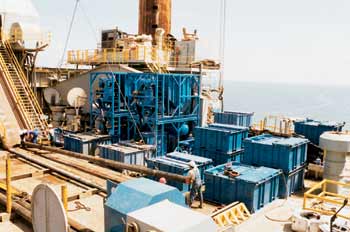Comparison of vacuum systems for zero discharge offshore applications
Requirements
- Reliability for continuous duty
- High vacuum and high air flow to maximize drilling productivity
- Cool operation for safety and reduced maintenance
- Non-sparking for compliance for Class 1, Division 1 operation

| Vacuum comparison |
|
Fan-type blower
|
Liquid ring pump
|
PD* w/cast iron impellers
|
Hydro Carbon PD*w/bronze impellers
|
|
|
Vacuum in inches of mercury
|
Up to 15″ Hg (lacks pulling power)
|
Up to 26″ Hg (only if service liquid is chilled)
|
16″ Hg and 27″ Hg types
|
26″ Hg
|
|
Air flow
|
High Cfm
|
Low to high Cfm
|
Low to high Cfm
|
Low to high Cfm
|
|
Continuous duty
|
Yes
|
Yes (with service liquid replenishment)
|
Yes
|
Yes
|
|
Auxiliary systems required
|
No
|
Yes (service liquid cooling and replenishment)
|
No
|
No
|
|
Non-sparking(reduced fire risk)
|
Available
|
Yes
|
No
|
Yes
|
|
Operating temperature
|
Self-cooling (if high airflow)
|
Cool (if service liquid is chilled)
|
16″ Hg blowers can run hot, 27″ Hg blowers self-cooling
|
Self-cooling
|
|
Pump size vs Cfm output
|
Large
|
Large
|
Compact
|
Compact
|
|
Maintenance factors
|
Minimum maintenance
|
Shaft seals may require service
|
Lip seals on 16″ Hg blowers may require service; 27″ blowers have durable piston ring seals
|
Minimum maintenance, durable piston ring seals
|
*Rotary-lobe positive displacement blowers
The key to productivity is high vacuum (26 – 27″ Hg)
Only high vacuum blowers can pull heavy loads or free blockages in vacuum hoses.
The key to continuous duty is proper filtration, no matter what type of blower or liquid ring pump. Proper filtration includes cyclones, filter baghouse and safety screen.
Without a baghouse, blower can be damaged or liquid ring pump’s liquid system will be contaminated with damaging sediment.